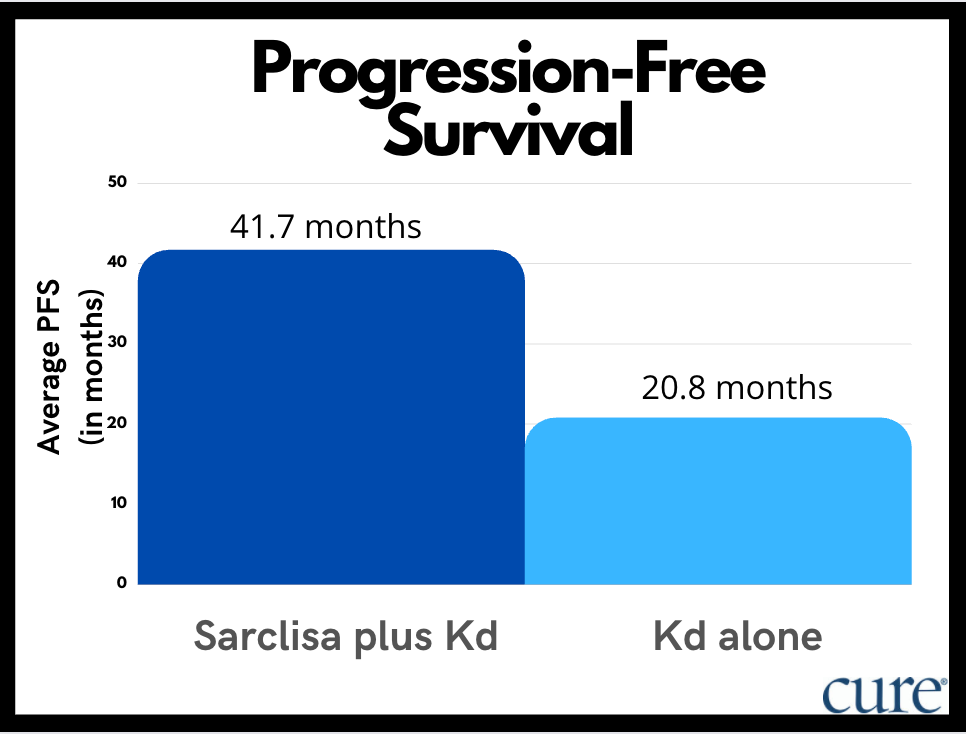Article
Sarclisa-Containing Treatment Regimen Shows ‘Remarkable’ Results for Relapsed Myeloma
Author(s):
The combination of Sarclisa, Kyprolis and dexamethasone improved progression-free survival in patients with pretreated, relapsed myeloma, and has potential to become a new standard of care, an expert said.
Adding Sarclisa (isatuximab) to a treatment regimen of Kyprolis (carfilzomib) and dexamethasone — a two-drug combination known as Kd — lengthened the amount of time patients with pretreated, relapsed myeloma lived before their disease got worse, according to findings from the phase 3 IKEMA clinical trial.
The study, which led to the 2021 Food and Drug Administration (FDA) approval of the regimen, compared outcomes of patients with relapsed myeloma that were treated with one to three prior therapies. Study participants were randomly assigned to receive Sarclisa (an intravenous drug) plus Kd or Kd alone, with the goal of the trial being progression-free survival (the time a patient lives without their disease getting worse).
Researchers also looked at overall response rate (percentage of patients whose disease shrunk as a result of treatment), complete response rate (percentage of patients who had no detectable cancer after treatment), very good or partial response rates, minimal residual disease-negativity rates, overall survival (time from treatment until death of any cause) and safety.
Sarclisa plus Kyprolis and dexamethasone improved progression-free survival compared to Kyprolis and dexamethasone alone (41.7 months, compared to 20.8 months, respectively) in patients with pre-treated, relapsed multiple myeloma.

Average progression-free survival for the Sarclisa-containing group was 35.7 months, compared to 19.2 months in patients treated with Kd alone, as reviewed by an Independent Review Committee. Censored analysis conducted by the FDA, which removes certain patients from the data pool before they experienced progression, average progression-free survival was 41.7 months in the Sarclisa plus Kd group, compared to 20.8 months in patients treated only with Kd.
“The increase in progression-free survival, observed consistently across all subgroups, when adding Sarclisa to (Kyprolis) and dexamethasone is remarkable in patients with relapsed multiple myeloma in a proteasome inhibitor combination,” Dr. Philippe Moreau, head of the department of Hematology at the University Hospital of Nantes in France, said in a press release.
Additionally, treatment with Sarclisa improved the lsength of time that patients had before they had to go on to the next treatment. On average, the Sarclisa group went 44.9 months before the next therapy, compared to 25 months in the Kd alone group.
There were no new side effects seen with IKEMA that were not previously seen in prior clinical trials of Sarclisa. The most common side effect for patients receiving Sarclisa included: infusion reaction (45.8% and 3.3% in the Sarclisa and Kd alone groups, respectively), diarrhea (39.5% and 32%, respectively), high blood pressure (37.9% and 35.2%), upper respiratory tract infection (37.3% and 27%), fatigue (31.6% and 20.5%), difficulty breathing (30.5% and 22.1%), pneumonia (27.1% and 21.3%), back pain (25.4% and 21.3%), insomnia (25.4% and 24.6%), and bronchitis (24.3% and 12.3%).
“Relapse is common in multiple myeloma, creating the need for differentiated second-line treatments that provide patients a longer period of time without disease progression. This updated analysis reinforces the potential for Sarclisa to become a new standard of care for patients with relapsed multiple myeloma,” Moreau said.
For more news on cancer updates, research and education, don’t forget to subscribe to CURE®’s newsletters here.



